|
|
|
Sort Order |
|
|
|
Items / Page
|
|
|
|
|
|
|
| Srl | Item |
| 1 |
ID:
149927
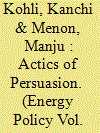

|
|
|
|
|
| Summary/Abstract |
Following the earthquake of 2001 in the Kutch district of Gujarat (India), the state government and corporate investors have focussed on the coastal areas of Kutch, India's largest district, for economic and infrastructure development. Within a decade of industrialisation of this landscape, these projects have had profound impacts on the environment, livelihoods and futures of its Kutchi inhabitants. Today, the coastline between the old Kandla and Mundra ports is drawn into a three-way battle between International Financial Institutions (IFIs) investing in coal projects, technical experts of sustainable development and international anti-coal campaigners. These three groups have selectively engaged the project affected Kutchis on the importance of economic development, environmental management and climate change. But the affected local people comprising artisanal fisherfolk who belong to a minority community, economically powerful salt and agricultural farmers and a traditional pastoral community of camel herders, frame, debate and act upon the impacts of the project in pragmatic ways. The range of remedies sought by them can be located between the practical expediency of everyday life and ethical questions about correct action. These remedies offer a glimpse of what regulatory bodies should be paying attention to rather than abstract or procedural justice.
|
|
|
|
|
|
|
|
|
|
|
|
|
|
|
|
| 2 |
ID:
149944


|
|
|
|
|
| Summary/Abstract |
As atmospheric CO2 continues to rise above 450 PPM, policymakers struggle with uncertainty concerning predictors of citizen support for environmental energy policies (EEPs) and preferences for their design, topics which have received limited attention in empirical literature. We present an original model of policy support based on citizens’ affinity-to-commons: pathways by which individuals enjoy natural public goods that in turn shape preferences between alternative policy mechanisms. We evaluate this model using a survey of southern California electricity customers, with results indicating the model's utility in predicting public support of EEP. Stronger community ties are associated with preferences for “pull”-type subsidies, whereas stronger connections to natural commons are linked to support for both “pull” and “push”-type sanctions. Findings have implications for coalition building as advocates may engender support for green energy policy by framing sanctions as protecting natural commons, and framing subsidies either in this same way and/or as producing benefits for communities.
|
|
|
|
|
|
|
|
|
|
|
|
|
|
|
|
| 3 |
ID:
149943


|
|
|
|
|
| Summary/Abstract |
The Covenant of Mayors (CM) is an initiative by which towns, cities and regions voluntarily commit to reduce their CO2 emissions beyond the European Union climate targets, through policies promoting energy saving and renewable energy. The aim of this paper is to analyze whether joining the CM is reducing municipalities' electricity consumption, and therefore their emissions. For this purpose, the evolution of total, household and public administration electricity consumption from 2001 to 2012 is analyzed by using panel data econometric techniques. This analysis is made for municipalities in Andalusia, the region of Spain with more signatories. Obtained results show that the CM is having a positive effect on the electricity consumption reductions, since the municipalities have greater rates of reduction of electricity consumption after signing the CM. Therefore, it may be considered appropriate to promote policies which incentivize the municipalities to join the CM and develop their action plans, as this can reduce their electricity consumption.
|
|
|
|
|
|
|
|
|
|
|
|
|
|
|
|
| 4 |
ID:
149918
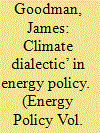

|
|
|
|
|
| Summary/Abstract |
Climate change expresses the global development crisis as a crisis for all societies. Governments in both over-developed and under-developed countries are forced to square the circle between climate crisis and energy policy. Across these contexts the policy imperative to reduce greenhouse gas emissions cascades into energy policy, and into wider fields of social and political life. The article investigates this process, advancing the concept of a ‘climate dialectic’ in policy change. From this perspective, the article develops a critique of climate policies as they have emerged in Germany and India. This positions Germany, a high-income post-industrial society, with India, a low-income industrialising country. Key climate and energy initiatives from each country are compared and discussed in terms of a common effort at expanded development opportunities. In this respect, with the key objective of maintaining ‘growth as usual’, the persistence of coal-fired power and coal extraction becomes highly politicised. Energy policies are found to be increasingly embedded in the wider ‘climate dialectic’, forcing new, more transformative possibilities onto the agenda.
|
|
|
|
|
|
|
|
|
|
|
|
|
|
|
|
| 5 |
ID:
149924
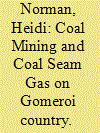

|
|
|
|
|
| Summary/Abstract |
North western NSW has seen a host of interest groups working in alliance opposing coal and coal seam gas mining. These groups - farmers, residents and environmentalists share concerns about the impact on the unique black soil and aquifer, of fossil fuel more broadly. While these shared alliances across class, gender and generations are emergent, Aboriginal citizens are uniquely placed in this contest over land, environment and resources. This paper sets out to show the historical and contemporary significance of the place of Aboriginal people in the debate over land use, arguing that, for the first time in history, Aboriginal worlds are central to community futures. In this space, new relationships are being forged and new discourse is required to comprehend the complex position Aboriginal citizens have as custodians of place and at the same time, the responsibility to provide for families and communities, otherwise excluded from the prevailing modern economy. With reference to the history of both relationship to land and land usage over Gomeroi country, and drawing on ethnographic along with archival research, this article seeks to contribute to a critical understanding of Aboriginal people's dealings in relation to their land, their cultural and economic interests with in an emerging regional coal economy, and in turn how they are redefining the context for energy resource extraction, and energy policy.
|
|
|
|
|
|
|
|
|
|
|
|
|
|
|
|
| 6 |
ID:
149932
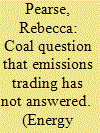

|
|
|
|
|
| Summary/Abstract |
Can emissions trading assist with the task of placing a limit on coal production and consumption in Australia? This paper outlines a critical political economy perspective on coal and a flagship ‘market mechanism’ for emissions reduction. The prospects for an effective emissions trading scheme in coal-dominated economies are considered in light of its theoretical justifications as well as recent attempts to price carbon in Australia. Emissions trading is a weak instrument that does not address real-world failures of coal governance. At their theoretical best, carbon prices produce marginal changes to the cost structure of production. In practice, the Australian case demonstrates emissions trading is an attempt to displace the emissions reduction task away from coal, through compensation arrangements and offsetting. In light of the urgent need to rapidly reduce global emissions, direct regulation and democratisation of coal production and consumption should be flagship climate policy.
|
|
|
|
|
|
|
|
|
|
|
|
|
|
|
|
| 7 |
ID:
149917


|
|
|
| 8 |
ID:
149922


|
|
|
|
|
| Summary/Abstract |
Over the last 50 years, German energy policy has ranged from strong enthusiasm for both coal and nuclear energy to deep skepticism. The most dramatic changes with respect to energy policies have occurred as a response to nuclear accidents, yet the accidental and unintended effects of coal policies are also important in influencing the trajectory. The newly emerging climate debate prevented the coal industry from acting as a substitute for the diminishing share of nuclear power. In 2011 the conservative government announced the Energiewende (‘energy transformation’) and decided to reduce the amount of fossil fuels from 80% of the energy supply to 20% by 2050. However, while the verdict on nuclear was unequivocal with a final phase-out date of 2022, the share of coal in the electricity market did not decrease and the amount of carbon dioxide released into the air slightly increased from 2011 to 2013. There are growing conflicts over the immediate costs and practicalities of coal replacement. Consequently, the future of coal in Germany is still relatively open and contested.
|
|
|
|
|
|
|
|
|
|
|
|
|
|
|
|
| 9 |
ID:
149937
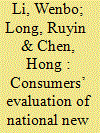

|
|
|
|
|
| Summary/Abstract |
The Chinese government has issued numerous policies to promote the development and adoption of new energy vehicles (NEVs) to address the problem of excessive energy consumption and environmental pollution. In this study we divided these policies into seven categories: macroscopic, demonstration, subsidization, preferential tax, technical support, industry management, and infrastructure. Since consumers’ opinions affect the policy choices of government, based on questionnaire data we use a four paradigm model to analyze the consumers’ evaluation of each policy in terms of perceptions of importance and satisfaction. The results show that macroscopic policies are perceived to be of high importance and satisfaction, whereas for industry management policies they are perceived to be of low importance and satisfaction. The importance perceptions of preferential tax and demonstration policies are low, whereas perceptions of their satisfaction are high. Perceptions of the importance of subsidization, technical support, and infrastructure policies are high, whereas perceptions of their satisfaction are low. We find that the subsidization, technical support, and infrastructure policies need urgent improvement. Finally, we put forward several suggestions to improve the current policies and increase the consumers’ intention to adopt NEVs.
|
|
|
|
|
|
|
|
|
|
|
|
|
|
|
|
| 10 |
ID:
149934


|
|
|
|
|
| Summary/Abstract |
In European countries, retailers are obliged to disclose the energy source and the related environmental impacts of their portfolio over the preceding year. The electricity supplied in the Dutch retail market is presented as renewable energy for 34%, but this relatively high share is for 69% based on certificates (Guarantees of Origin) which are imported from in particular Norway. The certificates are used to sell green electricity to consumers. The premium for green electricity which is actually paid by Dutch consumers is no more than a few percentages of the retail price. The low level of this premium is related to the abundant supply of certificates at low marginal costs from Norway. This also means that the premium for green electricity is too low to give an incentive for investments in new capacity. Hence, the current labelling system for renewable electricity is mainly valuable, besides being an instrument for tracking and tracing of renewable energy, as a marketing instrument for electricity retailers. The effectiveness of Guarantees of Origin as a policy instrument to foster renewable electricity sources is weak. This effectiveness can be raised by implementing restrictions on the international trade or the issuance of new certificates.
|
|
|
|
|
|
|
|
|
|
|
|
|
|
|
|
| 11 |
ID:
149931


|
|
|
|
|
| Summary/Abstract |
This article questions the assumption that carbon markets create a level playing field by exploring the relationship between the organisation of capital and the organisation of emissions in the European Union Emissions Trading System (EU ETS). It constructs a database by matching installations and owners to reveal that a relatively small number of large-scale coal-fired power stations, owned by a very small group of states and corporations, are responsible for a significant proportion of greenhouse gas emissions. The findings are analysed by considering how technological dependence on coal together with the corporate institutional form combine to support the socio-spatial concentration and centralisation of capital and emissions. Case studies of the consolidation of the seven largest polluting owners from Europe's coal-dependent electricity sector and the carbon trading strategies of the two largest polluters, RWE and E.ON, then assess the impacts of energy liberalisation and emissions trading policies. The article concludes that EU energy and climate policies are pulling in different directions by clustering responsibility for greenhouse gas emissions and diffusing responsibility to address climate change. The uneven distribution of emissions within the EU ETS makes an alternative policy approach that directly targets the biggest corporate and state polluters both feasible and necessary.
|
|
|
|
|
|
|
|
|
|
|
|
|
|
|
|
| 12 |
ID:
149939


|
|
|
|
|
| Summary/Abstract |
Increasing the energy efficiency not only requires the improvement of current technologies, but also advancement of and more coherent institutional governance. This paper captures the major structural and organisational elements of institutional governance in place for promoting energy efficiency. Looking at Croatia – one of the most successful cases of energy efficiency programming of the past decade – the paper zooms in on governance coordination (metagovernance) between actors from different sectors and operating at multiple levels. By showcasing the positive implications of the programme, the authors contribute to the debate concerned with identifying better institutional frameworks to attain sustainable development. The programme showed effective governance through vertical and horizontal coordination among institutions and stakeholders resulting in simultaneous social and economic development and improved energy efficiency in public buildings. Through the case of Croatia, this study identifies how metagovernance has supported coordination among actors aiming to create sustainable development in general and how metagovernance functions in energy efficiency related projects, in particular. The paper also sheds light on communication frameworks of governance coordination and institutional constraints lying at the heart of the vagueness of sustainable development. It also discusses private sector involvement to achieve better institutional framework to attain sustainable development.
|
|
|
|
|
|
|
|
|
|
|
|
|
|
|
|
| 13 |
ID:
149942


|
|
|
|
|
| Summary/Abstract |
The renewable energy targets put forward by the Chinese government need comprehensive incentive schemes. This paper uses a multi-regional CGE model to evaluate two types of renewable support schemes; a subsidy scheme like a feed-in tariff (FIT) with a direct price impact for final consumers and a subsidy scheme without any price impact. We assess the CO2 consequences of both approaches, as well as their impact on economic activity in terms of GDP, industrial structure, electricity generation structure, and regional final demand elasticities of electricity. We find that a support scheme with price impact is much more effective in reducing CO2 emissions while the difference in GDP between the two policies is small. We estimate that the price implications of the support scheme allow for an additional emissions reduction of 113 Mt CO2—or 0.07% of total emissions—in China during 2020–2035. The support scheme with a price impact does not lead to a negative impact on the Chinese economy although there are significant differences among regions. In addition, while the whole country faces an approximately unitary electricity elasticity demand, we find significant differences in electricity demand elasticities among Chinese regions.
|
|
|
|
|
|
|
|
|
|
|
|
|
|
|
|
| 14 |
ID:
149929


|
|
|
|
|
| Summary/Abstract |
One of the main ways that continued use of coal is justified, and compensated for, is through fantasies of technology. This paper explores the politics of 'Carbon Capture and Storage' (CCS) technologies in Australia. These technologies involve capturing CO2 emissions, usually to store them 'safely' underground in a process called 'geo-sequestration'. In Australia the idea of 'clean coal' has been heavily promoted, and is a major part of CO2 emissions reduction plans, despite the technological difficulties, the lack of large scale working prototypes, the lack of coal company investment in such research, and the current difficulties in detecting leaks. This paper investigates the ways that the politics of 'clean coal' have functioned as psycho-social defence mechanisms, to prolong coal usage, assuage political discomfort and anxiety, and increase the systemic disturbance produced by coal power.
|
|
|
|
|
|
|
|
|
|
|
|
|
|
|
|
| 15 |
ID:
149920


|
|
|
|
|
| Summary/Abstract |
Coal dominates energy production of modern India, shaping the economic and political milieu of the country and dictating its energy future. But invisible to the state’s view of coal running the nation, are roles played by this commodity in the livelihoods of millions of poor who live on the coal tracts of the country. In this paper, I argue that there are four coal economies — with yet another one lurking within or following behind as a shadow — in India. Each of these economies has different meanings of coal to those who are involved in the economy, producing the'diverse worlds’ of coal. To substantiate my argument, I critically analyse official and field-based primary data within a'diverse economies framework’ to present the intricate interlinkages among these worlds. I show that the multiple coal worlds are neither tiered in a hierarchical manner, nor'parallel’ in the sense of dualism implied in a simplified formal-informal dichotomy. Rather, these worlds of coal have different actors, and their domains are ruled by different norms and values about the qualities of coal as a material commodity; yet they overlap and intersect with each other through their complex labour regimes.
|
|
|
|
|
|
|
|
|
|
|
|
|
|
|
|
| 16 |
ID:
149923
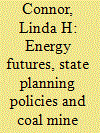

|
|
|
|
|
| Summary/Abstract |
The United Nations 2015 Climate Change Conference established a framework for keeping global temperature increase “well below” two degrees Celsius through commitments by the parties to significant reductions in greenhouse gas emissions. The agreement has implications for the energy policies of all countries, not least major coal exporters like Australia. By contrast, the government's 2015 Energy White Paper lays out the vision for the country's future as a “global energy superpower” dominated by the export of fossil fuels for decades to come. Legislative frameworks around planning, land use, mining, heritage and environment have moved in synchrony with this agenda. Rural landowners in the big coal rich geological basins of Australia are directly impacted by current government policies on energy exports and on domestic supply. This article follows the coal value chain to rural communities in New South Wales where new mines are being built, and analyses the politics of land use, natural resources and energy from the vantage point of landowner engagement with government and corporations in the policy, legislative and regulatory domains. The need for more equitable, democratic and precautionary approaches to energy policy, heritage and environmental planning and agricultural land use is highlighted.
|
|
|
|
|
|
|
|
|
|
|
|
|
|
|
|
| 17 |
ID:
149948
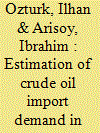

|
|
|
|
|
| Summary/Abstract |
The aim of this study is to model crude oil import demand and estimate the price and income elasticities of imported crude oil in Turkey based on a time-varying parameters (TVP) approach with the aim of obtaining accurate and more robust estimates of price and income elasticities. This study employs annual time series data of domestic oil consumption, real GDP, and oil price for the period 1966–2012. The empirical results indicate that both the income and price elasticities are in line with the theoretical expectations. However, the income elasticity is statistically significant while the price elasticity is statistically insignificant. The relatively high value of income elasticity (1.182) from this study suggests that crude oil import in Turkey is more responsive to changes in income level. This result indicates that imported crude oil is a normal good and rising income levels will foster higher consumption of oil based equipments, vehicles and services by economic agents. The estimated income elasticity of 1.182 suggests that imported crude oil consumption grows at a higher rate than income. This in turn reduces oil intensity over time. Therefore, crude oil import during the estimation period is substantially driven by income.
|
|
|
|
|
|
|
|
|
|
|
|
|
|
|
|
| 18 |
ID:
149930


|
|
|
|
|
| Summary/Abstract |
The Production Tax Credit (PTC) is an important policy instrument through which the federal government promotes renewable energy development in the United States. However, the efficacy of the PTC is hampered by repeated expirations and short-term extensions, and by the general uncertainty surrounding its future status. We examine the factors driving variation in public support for the extension of the PTC using a nationally representative, internet-based survey. Americans living near a coal-fired power plant are significantly more likely to support extending the PTC than are their peers who are more insulated from the externalities of burning coal. The evidence for this dynamic was strongest and most statistically significant among subjects experimentally primed to think about the adverse health effects of burning coal. Raising awareness of the public health ramifications of generating electricity from fossil fuels holds the potential to increase support for renewable energy policies among those living in proximity to coal plants, even in a highly politicized policy debate.
|
|
|
|
|
|
|
|
|
|
|
|
|
|
|
|
| 19 |
ID:
149935


|
|
|
|
|
| Summary/Abstract |
Since 2009, the subsidy for large-scale photovoltaic (PV) power plants had been launched, which effectively promoted the development of PV industry. At the same time, negative effects, like serious oversupply of PV industry, were brought about by these large scale governmental subsidies. Although governmental subsidy strongly supports the China PV companies, few of them have competitiveness in the global market. This dramatically conflictive phenomenon attracted many researchers’ attentions in recent years. However, investigations on the best entry and exit occasions of governmental subsidies for the PV industry were rarely reported in previous studies. Therefore, based on the existing division method of enterprise development model, classification of 72 PV companies listed in Shanghai and Shenzhen Stock Exchanges in China was firstly carried out in this paper. This is followed by studying the influence of governmental subsidies on the indexes of different stages of enterprise development. Finally, a conclusion was drawn that the governmental subsidies at Early Exploratory Stage can maximize the social and economic effects, suggesting the best entry occasion, and subsidies at Intermediate Stage and Mature Stage have little effects on its turnover and aggravate the overcapacity of PV supply, suggesting a suitable exit occasion.Since 2009, the subsidy for large-scale photovoltaic (PV) power plants had been launched, which effectively promoted the development of PV industry. At the same time, negative effects, like serious oversupply of PV industry, were brought about by these large scale governmental subsidies. Although governmental subsidy strongly supports the China PV companies, few of them have competitiveness in the global market. This dramatically conflictive phenomenon attracted many researchers’ attentions in recent years. However, investigations on the best entry and exit occasions of governmental subsidies for the PV industry were rarely reported in previous studies. Therefore, based on the existing division method of enterprise development model, classification of 72 PV companies listed in Shanghai and Shenzhen Stock Exchanges in China was firstly carried out in this paper. This is followed by studying the influence of governmental subsidies on the indexes of different stages of enterprise development. Finally, a conclusion was drawn that the governmental subsidies at Early Exploratory Stage can maximize the social and economic effects, suggesting the best entry occasion, and subsidies at Intermediate Stage and Mature Stage have little effects on its turnover and aggravate the overcapacity of PV supply, suggesting a suitable exit occasion.
|
|
|
|
|
|
|
|
|
|
|
|
|
|
|
|
| 20 |
ID:
149928


|
|
|
|
|
| Summary/Abstract |
The German Energiewende, or energy transition, is an ambitious suite of policy measures which aim to decarbonize the German economy and achieve an almost complete transition to an energy system based on renewable energy by mid-century. This article contends that the energy transition is also a social process. We develop a provisional local ethnography of the Energiewende, an account of the lived experience of this social process from the perspective of villagers in Atterwasch, Kerkwitz and Grabko, in the region of Lusatia in Eastern Germany. Their experiences are particularly salient, since their villages are facing demolition to make way for the expansion of the nearby Jänschwalde coal mine. The villagers’ struggle to defend their homes highlights a fundamental contradiction in the energy transition, sometimes referred to as the “coal conundrum”. The contest over the future of coal in Lusatia can be seen as a struggle to control key cultural ‘scripts’ or narratives, of home, belonging, ecological modernization, climate change, and democratic deficit. Our research suggests that any resolution of the coal conundrum, and effective implementation of the Energiewende, must be informed by an understanding of these scripts, and how they underpin the motivations and mentalities of different social actors.
|
|
|
|
|
|
|
|
|
|
|
|
|
|
|
|
|
|
|
|
|